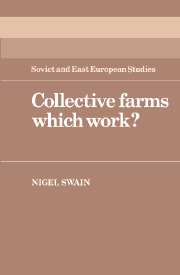Book contents
- Frontmatter
- Contents
- Preface
- Introduction
- PART I ‘FAMILY LABOUR’ AND ‘SOCIALIST WAGE LABOUR’ IN HUNGARY'S CO-OPERATIVE AGRICULTURE: THE INCORPORATION OF PETTY COMMODITY PRODUCTION
- PART II MEMBERS AND MANAGERS
- 3 The social composition of the agricultural producer co-operative labour force
- 4 Professional management on agricultural producer co-operatives: genesis and social characteristics
- PART III MANAGERIAL CONTROL IN AGRICULTURE
- Conclusion
- Appendix I The transformation of Hungarian agriculture
- Appendix II Ancillary enterprises within agricultural co-operatives: number of units engaged in non-agricultural activity
- Notes
- References and bibliography
- Index
3 - The social composition of the agricultural producer co-operative labour force
Published online by Cambridge University Press: 10 December 2009
- Frontmatter
- Contents
- Preface
- Introduction
- PART I ‘FAMILY LABOUR’ AND ‘SOCIALIST WAGE LABOUR’ IN HUNGARY'S CO-OPERATIVE AGRICULTURE: THE INCORPORATION OF PETTY COMMODITY PRODUCTION
- PART II MEMBERS AND MANAGERS
- 3 The social composition of the agricultural producer co-operative labour force
- 4 Professional management on agricultural producer co-operatives: genesis and social characteristics
- PART III MANAGERIAL CONTROL IN AGRICULTURE
- Conclusion
- Appendix I The transformation of Hungarian agriculture
- Appendix II Ancillary enterprises within agricultural co-operatives: number of units engaged in non-agricultural activity
- Notes
- References and bibliography
- Index
Summary
In this chapter we shall consider the social composition of the agricultural producer co-operative labour force which was created as the two labour types – ‘family labour’ and ‘socialist wage labour’ – were integrated within Hungarian co-operative farms. Who became what in the new agricultural world; and how, and by whom, are ‘family labour’ and ‘socialist wage labour’ combined? What were the effects of collectivisation and the growth and integration of ‘family labour’ and ‘socialist wage labour’ on peasants as social groups? As a prelude for these sociological questions, however, we should focus first on two issues of a more economic nature: the changes which took place in the demand for labour, and types of labour, as collective farms developed, and the transformation of the farms' occupational structure.
Demand for labour within Hungarian agriculture changed considerably throughout the 1960s as mechanisation and the evolution of the wage-labour form not only modified the degree of the intensity of demand, but also created a complex occupational structure with new skills and new occupational categories. The general pattern of the relationship between labour supply and mechanisation was the following. Mechanisation first, belatedly, made up for the shortage of suitably qualified labour that had prevailed as labour moved out of agriculture en masse and that which remained was reticent about joining in communal agriculture. It then proceeded to compound the continuing problem of periodic unemployment and underemployment of suitably qualified labour by increasing the seasonality of demand. At the same time, mechanisation increased enormously the number of ‘skilled’ tasks in agriculture, as well as those which were intrinsically industrial in nature.
- Type
- Chapter
- Information
- Collective Farms which Work? , pp. 83 - 113Publisher: Cambridge University PressPrint publication year: 1985



